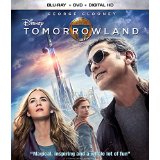Walt Disney was a dreamer. Some of his dreams were realized. Some were not. Disney built a kingdom. He built more than one, in fact. One of Walt’s dreams that was not realized was the experimental prototype community of tomorrow (EPCOT). He did incorporate some of the ideas of EPCOT into the Disney World theme park, but it was a mere shadow of the original dream. One of the essential elements of EPCOT was, and is, Tomorrowland. Disney was widely admired in the 1960’s by urban planners for his visionary views about the possibilities of the future.
Unfortunately, Disney died in 1966, and the board of directors severely cut back Walt’s original vision. Of course, Disney World wound up on 27,258 acres that is a short drive from NASA’s main launch site, Cape Canaveral.
In the film Tomorrowland, Casey Newton (Britt Robertson) is the daughter of Eddie (Tim McGraw), who is an engineer at NASA. Unfortunately, NASA is not what it used to be, and Eddie is being phased out. In a separate storyline, years earlier in 1964, a young inventor shows up at the New York World’s Fair (the time and place that Disney introduced many innovations) with a flying jet pack. That inventor grows up and is central to the story. That young inventor grows up to be grouchy malcontent, Frank Walker (George Clooney). David Nix (Hugh Laurie) is also important to the story, because he is the inventor of Tomorrowland, and Nix first meets Walker at the 1964 World’s Fair. A magical young girl named Athena (Raffey Cassidy) is the final essential ingredient, because she is the catalyst for change throughout the story.
There is so much fantastic and wonderful stuff in this movie that you wished the movie as a whole was just as fantastic. It might be that there is too much fantastic stuff. Part Back to the Future, Peter Pan and Men in Black, the film is erratic, uneven, and confusing. I liked the movie, but it might have benefited from a less downbeat tone and less confusing plot elements. There is plenty of fun stuff, as well as violent and depressing parts. For instance, the men in black in this case are passive/aggressive humanoids whose aggressive side includes disintegrating people who get in their way. By the way, Tomorrowland is in another dimension.
As is the case with most stories about the future, tomorrow is not very bright.
Damon Lindelof (Lost, Star Trek I and II, World War Z) and Brad Bird (The Incredibles, Mission Impossible – Ghost Protocol, Ratatouille) co-wrote the script which Bird directed. These are both very competent men. They created an original concept and presented what they thought was best. They decided to make this non-sequel a little darker than it needed to be. That’s not the problem. It’s a matter of finding just the right balance, and that can be tricky. Bird and Lindelof envisioned a bleak future, and then they also tried to give us hope. That’s not an easy message for a big-budget, tent-pole summer blockbuster. I should also mention there is a strange romantic undercurrent that takes place between two characters that works well, but I won’t reveal it, because…it’s odd.
I understand why Disney saw great possibilities in creating a franchise around one of its theme parks. The most successful movie of the year played on that theme park notion and had enormous success. The difference is that Jurassic World was a sequel and was very generic and safe in its choices. Tomorrowland took more chances and, as an origin story, was always going to be a harder sell.
Tomorrowland is a message film. It’s telling us we have to be smarter and work harder if we’re going to avoid destroying ourselves. That message might be too open-ended for audiences who want simple answers.



